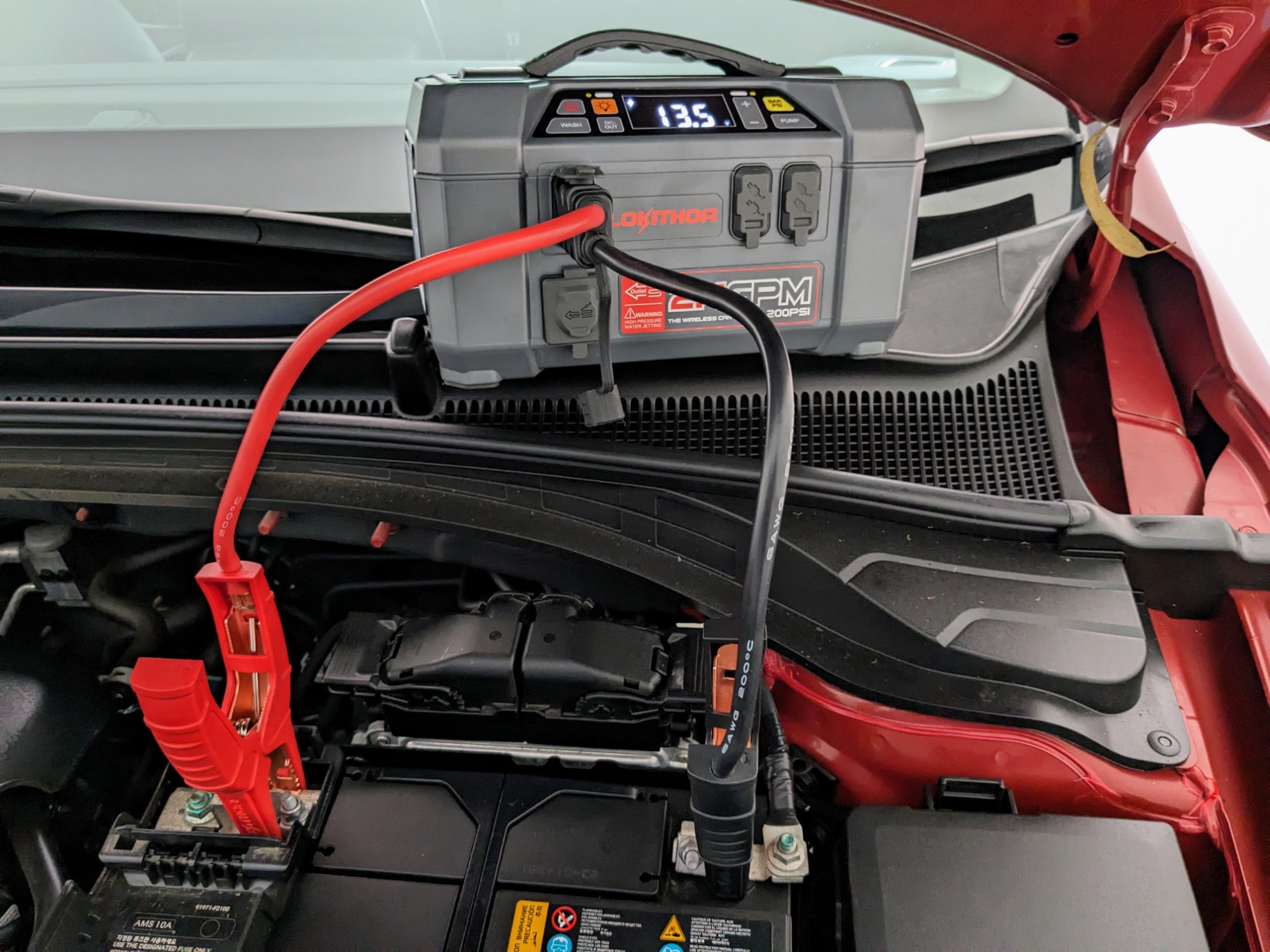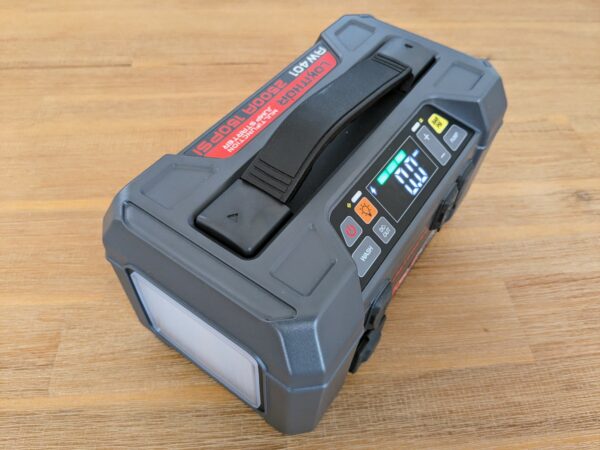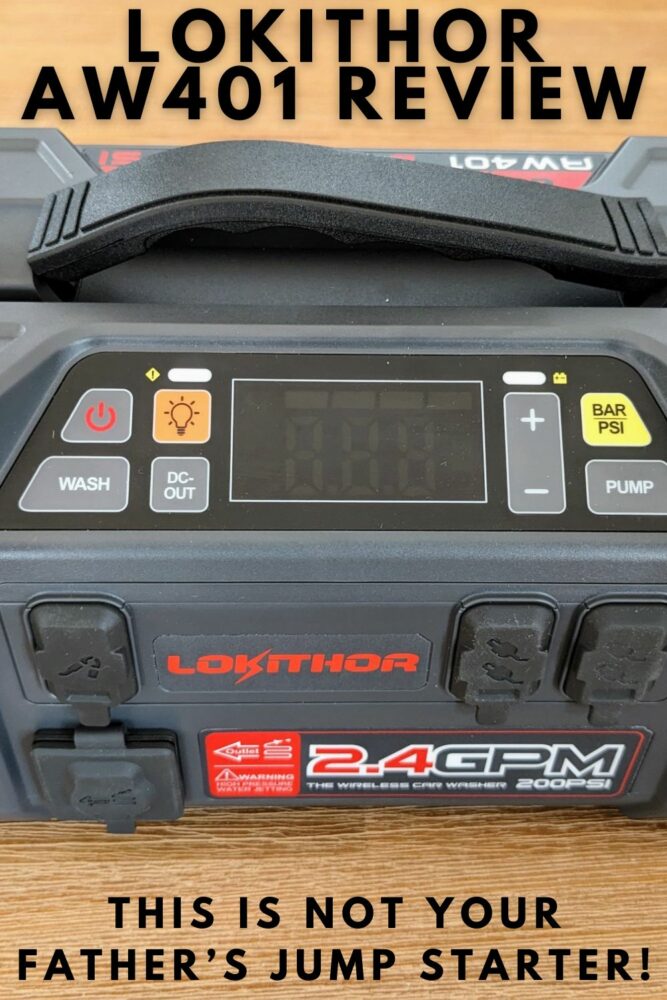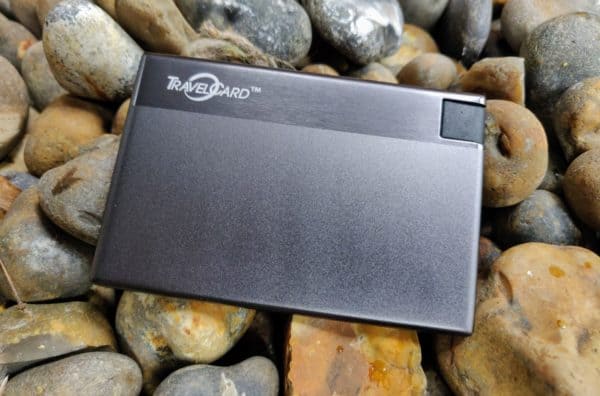Lokithor AW401 Review: Not Your Father’s Jump Starter!
We may earn a commission from purchases you make after clicking links on this site. Learn more.As a category, portable jump starters are very much one of those things that most people don’t think about until approximately ten seconds after their car refuses to start. That’s especially true if you happen to be in the middle of nowhere at the time, even more so if you don’t have cell service to call roadside assistance.
To be honest, I suspect many drivers don’t even know these kinds of gadgets exist: they used to be big, heavy, and expensive, and really only used by mechanics and other professionals. Better battery tech made a big difference, though, and now there are hundreds of different models out there, made by dozens of different companies.
Lokithor is one such company, making a range of multifunction jump starters aimed squarely at the home market. All of the models let you jump-start your vehicle, signal for help, and charge your phone, but some do much more.
That includes the high-end AW401, which adds an air compressor and water pump into the mix. This is the third model that the company has sent out for me to take a look at, and the most expensive of the three.
I was intrigued to see just what that extra money buys you!
- Weight: 7.25 pounds
- Battery Capacity: 20,000mAh
- Peak/Cranking Amps: 2500/1500
- Air Compressor: Up to 150 PSI
- Water Pump: Up to 200 PSI
- Flashlight: 500 lumens (three modes)
- Ports: USB-A (18W max), USB C (60W max)
Box Contents
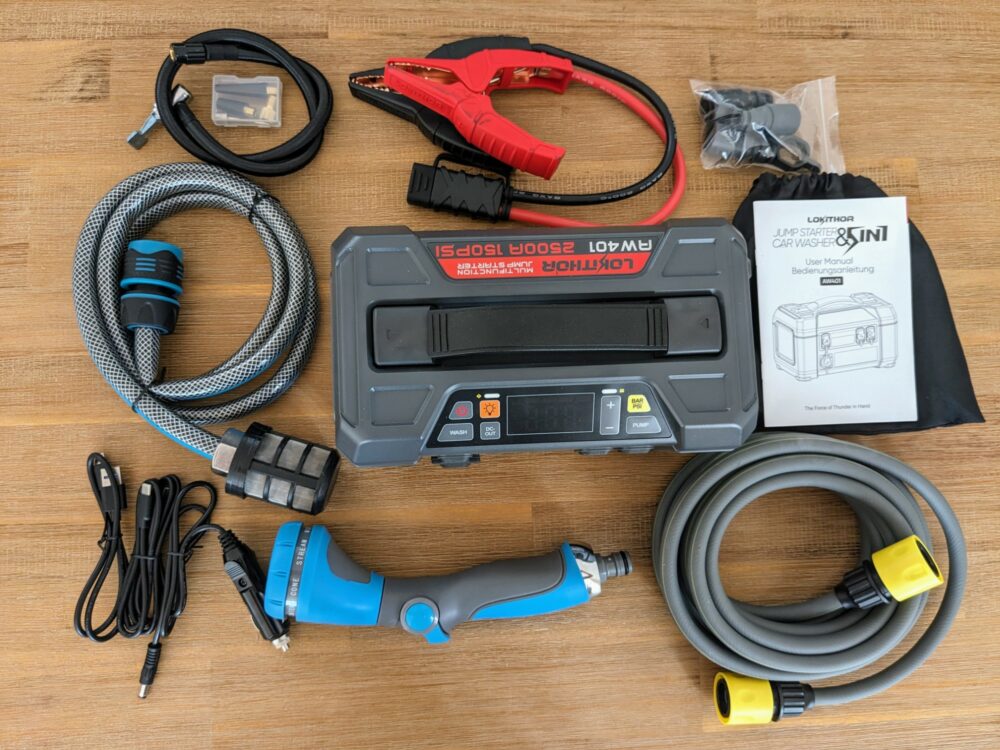
The box that arrived at my door was much larger than the ones for other Lokithor jump starters I’ve used, and the reason why was obvious as soon as I opened it up. Not only is the main unit much larger and heavier than the J401 or JA301, but there are a lot more accessories as well.
There are two types of hose, an adjustable nozzle, and a bunch connectors and O rings, and that’s just for the water pump. Throw in jumper cables for the battery, hoses and adapters for the air compressor, a car charger, and a couple of USB cables, and let’s just say it feels like you’re getting plenty for your money.
Thankfully there’s been some thought put into the management of all this stuff: with so many connectors and adapters, I’d be worried about losing something important otherwise. There’s a drawstring bag big enough to hold everything not related to power washing, and plastic bags and boxes to keep the smallest parts together.
That feels like a good compromise, since those are the parts you’ll likely keep in your vehicle all the time. I’ll get less use from the water pump away from home, but I always want the option of jump-starting a dead battery or pumping up a flat tire.
Lokithor does a better job than most with their manuals. I commented on this with the other models as well, but the diagrams and instructions are clear and easy to understand, which is quite important here given how many different options there are.
The Main Unit
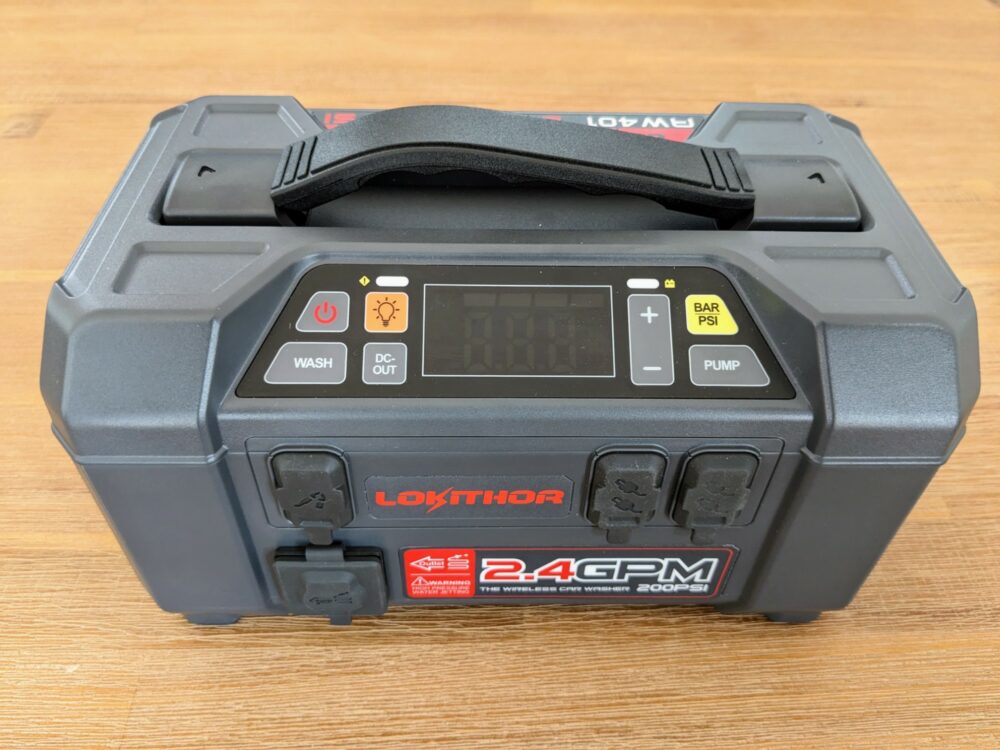
Lokithor makes some portable jump starters that fit in a glove compartment, and others that fit easily under your seat. The AW401…does not do either of those things. At roughly 10 x 6 x 6 inches and over seven pounds, it’s a bit of a beast.
You’ll more than likely want to keep it in your trunk. If you do, I’d suggest cutting out the section of packing foam that surrounds it in the box and storing it inside that for a bit of extra protection. There’s currently no travel case available for this model: even though the plastic case feels very sturdy, this seems like an oversight.
There’s a carry handle on top, along with an array of buttons for controlling the various features. The simple LED screen that lets you know how much charge is left in the battery and the current battery voltage or air compressor pressure.
It’s all pretty straightforward: in general a long press of a button turns a feature on, and a short press turns it off again. Those features include the flashlight, water pump, air compressor, and the DC-Out port, plus switching the units for the compressor from PSI to bar.
Most of the connection ports and sockets are on the front: two connectors for the battery clamps, DC in and out ports, USB C and A sockets, and the outlet for the water pump. They’re all covered by rubber plugs that protect them from the elements (or for the water outlet, keep residual water inside the unit once you’ve finished using it).
The air outlet is on one end, while the other end is almost entirely made up of the large LED lamp for the flashlight. Finally, the rear of the unit holds the inlet for the water pump, along with instructions on how to use it.
Jump Starter and Battery Monitor
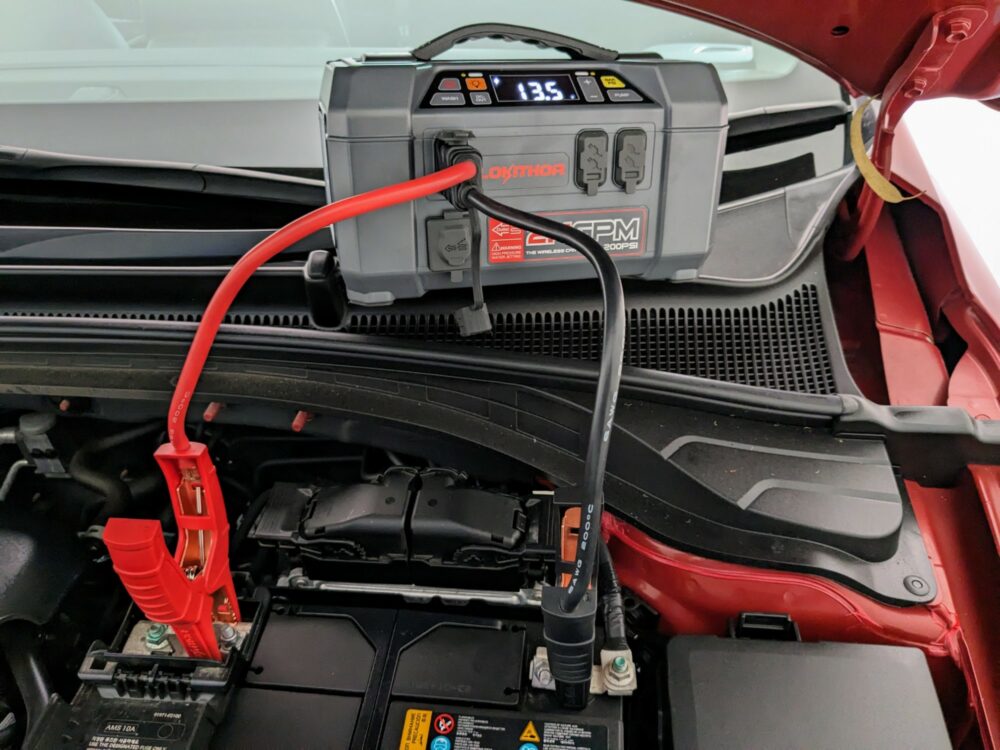
The jump starter is rated to put out up to 2500 peak amps, and 1500 cranking amps. That’s powerful enough to start vehicles with up to an 8.5 liter gas engine or 6.5 liter diesel, including cars, boats, and small RVs. You can also use it as a voltmeter, checking the voltage of your vehicle battery to see whether it’s in a healthy state.
Like all of the Lokithor models I’ve tested, the jumper cables are quite short: it’s not an issue in the engine bay of my hatchback, but you might have to work a bit harder to find somewhere to sit the unit in larger vehicles.
It’s easy to use if your battery is flat, though: after connecting the cables and turning the unit on, all you need to do is start the vehicle. By default the screen shows the combined voltage of the vehicle battery and the unit; if you only want to see how much voltage the battery has by itself, just quick-press the power button.
My car battery measured 13.5 volts by itself and 14.2 volts with the assistance of the jump starter. No need for a replacement just yet!
Air Compressor
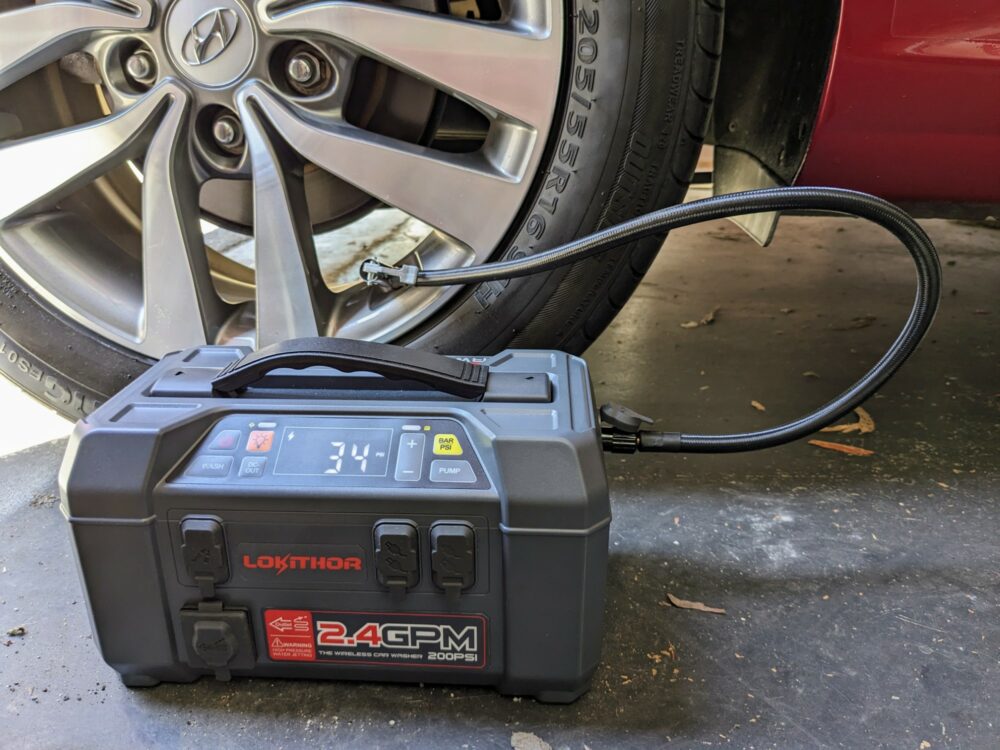
Most of my comments about the jump starting aspect apply to the air compressor as well: the air hose is a bit shorter than I’d like, but it’s easy to use and works well. Much like the battery monitor, you can also use it to see the current tire pressure just by connecting the hose and powering on the unit.
One aspect I particularly like is the ability to set a desired pressure. You just push the plus/minus toggle to change the number, then hit the pump button and leave the compressor running. It automatically switches off when it gets to the right pressure, eliminating the risk of over-inflation or worse.
Pressing the bar/PSI button switches between the two units of measurement, depending on what you’re most comfortable with.
I discovered that one of my rear tires was down slightly while testing the unit; it took under thirty seconds to give it the three pounds of extra pressure it needed. Certainly a lot quicker than driving to the gas station to do it!
Water Pump
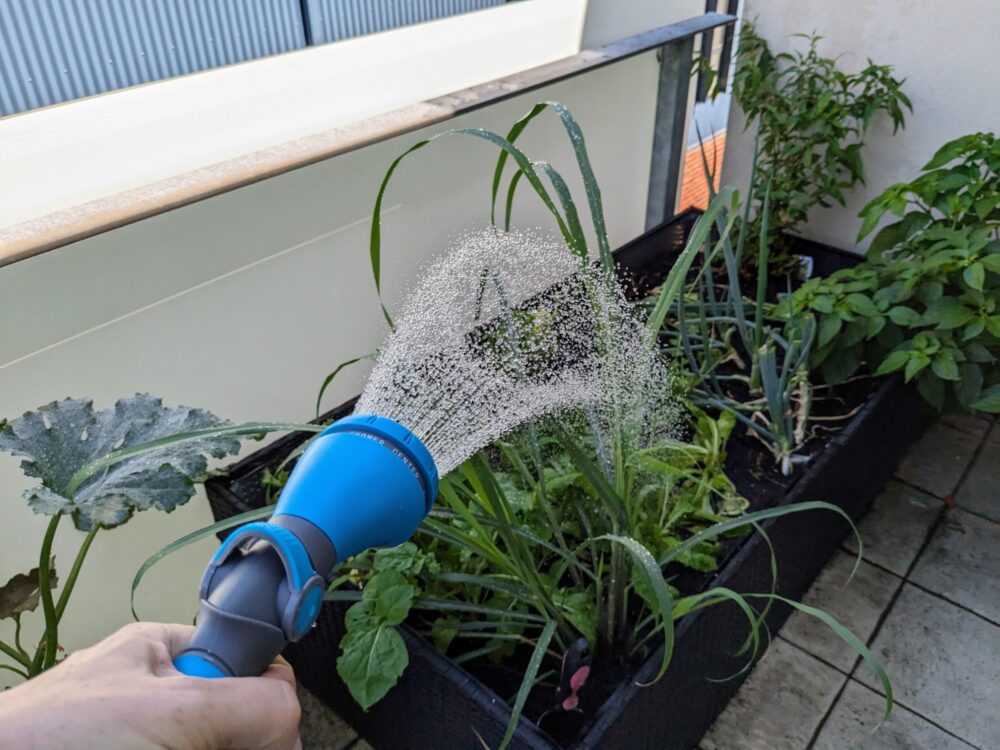
I was intrigued by the water pump, as it’s the main difference between this model and smaller versions like the JA301. Setting it up is easy enough: you screw plastic connectors into the water ports, then connect the shorter hose to the inlet port and the longer one to the outlet port.
The inlet hose has a filter on the other end, and is designed to be placed in a bucket or other container filled with water. The outlet hose has a standard connector to attach the adjustable nozzle.
The nozzle has a whole range of settings, from mist and shower to various higher-pressure options. Don’t be mistaken though, this isn’t a power washer: it’s good for rinsing dirt or detergent off your car, but you won’t be blasting years of accumulated grime off your driveway with it.
Still, for my particular situation at least, I found it useful. I live in an apartment and don’t have an outdoor tap to wash my car with, so being able to spray off dirt and soapy water with some degree of force rather than doing it all by hand sped the process up a lot.
That said, it only takes about a minute to empty a two-gallon bucket, so I’d probably invest in a larger container if I was doing this all the time.
I tested out the low-pressure settings by watering the plants on my balcony, since there’s no outdoor tap there either. I wouldn’t say there’s a big difference between this and just using a watering can, but the option’s there if you need it.
Charging and Other Features
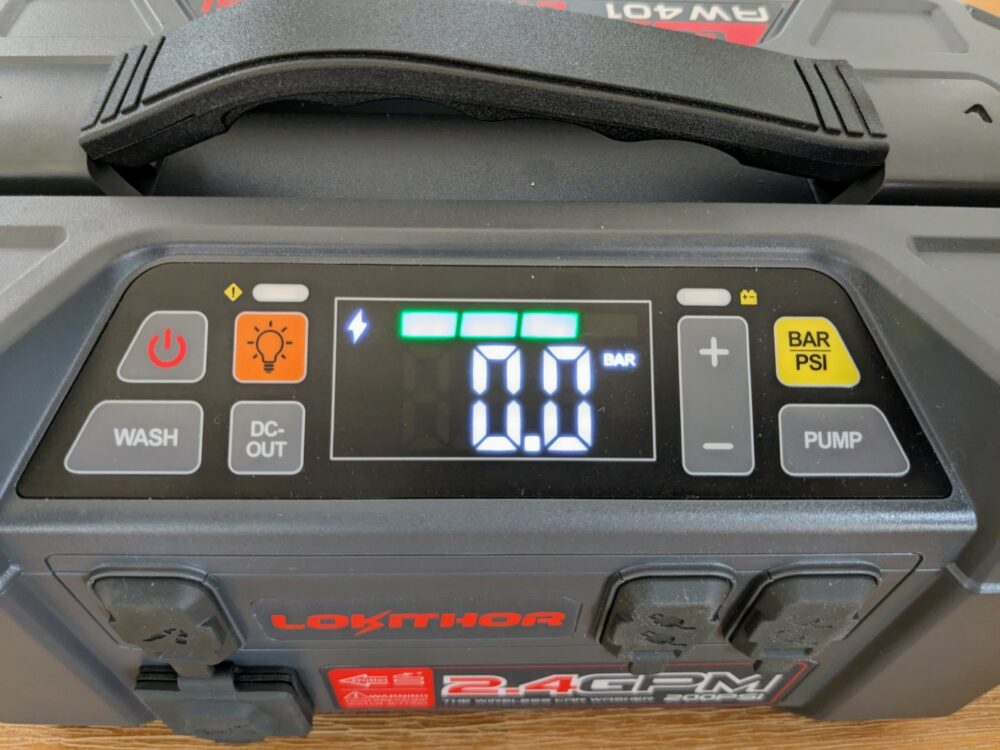
There’s a 20,000mAh battery inside the unit, which is about the same capacity as a large power bank and enough for up to 60 jump starts from a full charge. You only get a rough idea of how much capacity is left from the four status LEDs, but it doesn’t really need to be any more accurate than that.
If you don’t think you’ll need all that juice for jumping your vehicle, you can use it to charge your mobile devices instead. The USB C port is rated for up to 60W, which is powerful enough to fast-charge phones, tablets, and most laptops. The USB-A port puts out up to 18W, which is plenty for a phone or anything smaller.
I double-checked the manufacturer’s claims, and they were accurate: plugged into the USB C port, my power tester briefly climbed to 61W before settling back to around 55W.
I only got around 7W from the USB-A port, because none of my devices support the QC standard needed to get a higher amount. There was no noticeable drop in output when charging from both ports at once.
Charging the internal battery can be done from either the included car charger or any sufficiently-powerful USB C wall charger. There’s no wall charger in the box, but most people already have one for their laptop or phone these days: if you don’t, Lokithor sells a bundle that includes one. It took just over 80 minutes to fully charge the unit from a 60W charger.
The flashlight on the end is rated at 500 lux, and is noticeably brighter than the versions that come with any of the other Lokithor jump starters I’ve used. It’s still better at illuminating a larger area up close than picking out something in the dark a hundred feet away, but I’d be quite happy using it to get around a dark campsite.
As well as the standard beam, there are two emergency modes: a quickly-flashing strobe, and one that flashes SOS. You just press the flashlight button to switch between them.
Get regular updates from the world of travel tech and remote work
News, reviews, recommendations and more, from here and around the web
Should You Buy It?
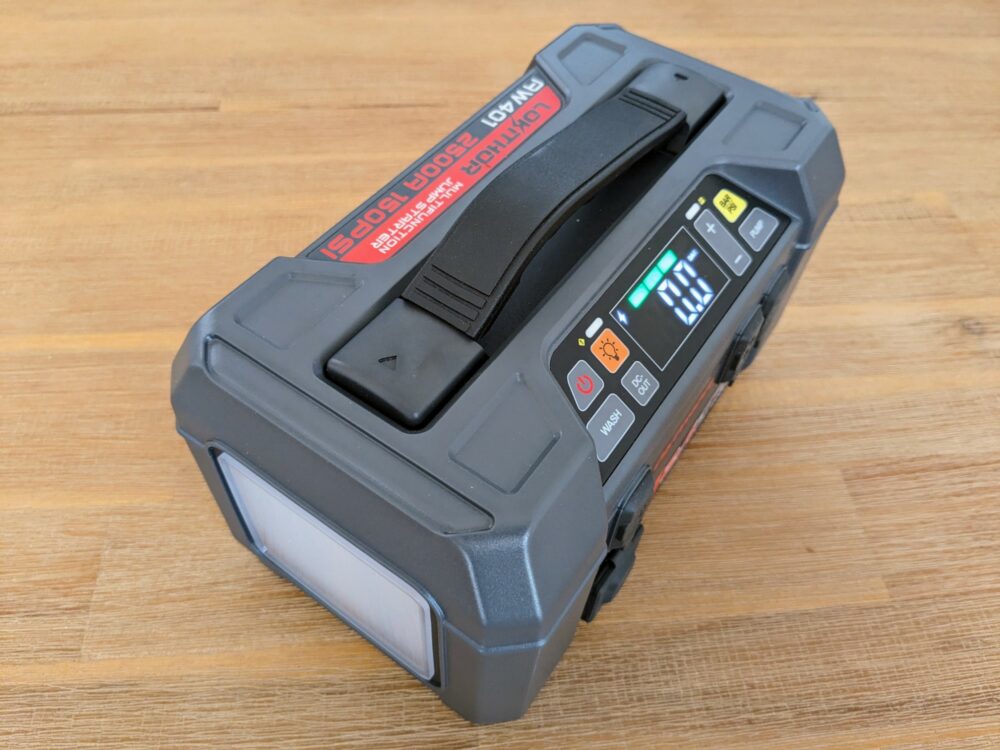
So, the big question: should you buy the Lokithor AW401? Of the three models I’ve used over the last year, this is the one with the most nuanced answer. There’s no question that it’s up to the company’s usual standard: it’s rugged, reliable, does a lot, and every feature works as advertised.
It’s a device I’d be very glad to have in my car for all kinds of situations, from dead batteries to flat tires and more. The problem, I guess, is that the same comment is true for the JA301 model, which does almost as much, costs noticeably less, and fits easily under my seat.
Sure, you do miss out on a few things. There’s no water pump or USB C charging on the JA301, and the flashlight isn’t as powerful. They’re all useful features, but are they worth the extra money? For some people, yes, but not for everyone.
So I guess what I’m saying here is: have a think about where and how you’re most likely to use a device like this before you buy it. If you’ll get value out of that water pump, the AW401 is the way to go. If not, the cheaper JA301 or JA401 are probably better bets.
Don’t get me wrong, all of them are good options when it comes to a portable “first aid kit” for your vehicle: having now used a few different models, I have no concerns about recommending Lokithor devices. Just make sure you pick the best one for your particular situation!
Pros
Cons
All images via author

